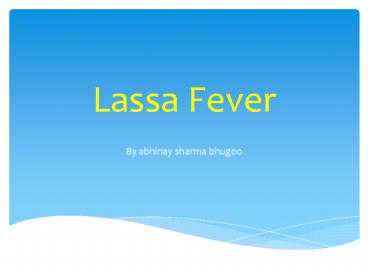Lassa Fever - PowerPoint PPT Presentation
1 / 21
Title:
Lassa Fever
Description:
Lassa Fever By abhinay sharma bhugoo Viral hemorrhagic fever caused by the Arenavirus Lassa Transmitted from rodents to humans Discovered in Nigeria, 1969 Endemic in ... – PowerPoint PPT presentation
Number of Views:465
Avg rating:3.0/5.0
Title: Lassa Fever
1
Lassa Fever
- By abhinay sharma bhugoo
2
General Facts
- Viral hemorrhagic fever caused by the Arenavirus
Lassa - Transmitted from rodents to humans
- Discovered in Nigeria, 1969
- Endemic in portions of West Africa
- Seasonal clustering Late rainy and early dry
season - Affects all age groups and both sexes
3
Arenaviridae
- Name derived from arenosus (Latin sandy)
describing appearance of virions on examination
by electron microscopy - Enveloped virus, round or pleomorphic, 50-300 nm
in diameter - Single-stranded genome divided into 2 RNA
segments small (3.4 kb) and large (7.1 kb) - 2 genes on each segment, arranged in unique
ambisense orientation, encoding 5 proteins - Inactivated by
- heating to 56oF
- pHlt5.5 or gt8.5
- UV/gamma irradiation
- detergents
4
Arenaviridae
- Arenaviruses associated with human disease
- Virus Origin of Name Year Distribution
- Lassa Town, Nigeria 1969 West Africa
- Junin Town, Argentina 1957 South America
- Machupo River, Bolivia 1962 South America
- Guanarito Area, Venezuela 1989 South America
- Sabia Town, Brazil 1990 South America
- LCMV Clinical disease 1933 Worldwide
5
Lassa Virus
Image source C.S. Goldsmith and M. Bowen (CDC).
6
Epidemiology
- Endemic in areas of West Africa, including
Nigeria, Liberia, Sierra Leone, and Guinea - Estimated 300,000-500,000 infections/year, with
5000 deaths - Rodent-to-human transmission (the multimammate
rat, Mastomys species-complex) - Secondary human-to-human transmission with the
potential for nosocomial outbreaks with high
case-fatality
7
Known Distribution of Mastomys
MASTOMYS DISTRIBUTION
LASSA 1969
8
Rodent Reservoir
- Mastomys species complex
- Taxonomy still unclear
- M. huberti more common in peridomestic habitat
- M. erytholeucus more common in brush habitat
- Others
9
Transmission
- Rodent-to-human
- Inhalation of aerosolized virus
- Ingestion of food or materials contaminated by
infected rodent excreta - Catching and preparing Mastomys as a food source
10
Transmission
- Human-to-human
- Direct contact with blood, tissues, secretions or
excretions of infected humans - Needle stick or cut
- Inhalation of aerosolized virus
11
Pathogenesis
- Endothelial cell damage/capillary leak
- Platelet dysfunction
- Suppressed cardiac function
- Cytokines and other soluble mediators of shock
and inflammation
12
Clinical Aspects
- Incubation period of 5-21 days
- Gradual onset of fever, headache, malaise and
other non-specific signs and symptoms - Pharyngitis, myalgias, retro-sternal pain, cough
and gastrointestinal symptoms typically seen - A minority present with classic symptoms of
bleeding, neck/facial swelling and shock - Case fatality of hospitalized cases 15-20
- Particularly severe in pregnant women and their
offspring - Deafness a common sequela
13
Clinical Signs and Symptoms
Fever
Headache
Arthralgias/Myalgias
Retro-sternal Pain
Weakness
Dizziness
Sore throat/Pharyngitis
Cough
Vomiting
Abdominal Pain/Tenderness
Diarrhea
Conjunctivitis/Sub-conjunctival
Hemorrhage
Chills
Deafness
Lymphadenopgathy
Bleeding
Confusion
Swollen Neck or Face
0
10
20
30
40
50
60
70
80
90
100
Percent
14
Lassa Fever in Pregnancy
- Increased maternal mortality in third trimester
(gt30) - Increased fetal and neonatal mortality (gt85)
- Increased level of viremia in pregnant women
- Placental infection
- Evacuation of uterus improves mothers chance of
survival
15
Sensorineural Hearing Deficit in Lassa Fever
- Typically appears during early convalescence
- Not related to severity of acute illness
- Occurs in one-third of cases
- May be bilateral or unilateral
- May persist for life in up to one-third of those
affected
16
Lassa Fever in Children and Infants
- Significant cause of pediatric hospitalizations
in some areas of West Africa - Signs and symptoms most often similar to adults
- Swollen Baby Syndrome
- - Edema/Anasarca
- - Abdominal distension
- - Bleeding
- - Poor prognosis
17
Differential Diagnosis of Lassa Fever
- Malaria
- Typhoid fever
- Streptococcal pharyngitis
- Leptospirosis
- Bacterial sepsis
- Bacterial meningitis
- Arboviral infection
- Anicteric hepatitis
- Enterovirus infection
- Bacterial or viral conjuctivitis
18
Diagnostics
- Clinical diagnosis often difficult
- ELISA (Enzyme-linked immunosorbent assays) for
antigen, IgM, and IgG - As research tools
- Virus isolation
- Immunohistochemistry (for post-mortem diagnosis)
- RT-PCR (Reverse transcription-polymerase chain
reaction)
19
Treatment
- Supportive measures
- Ribavirin
- Most effective when started within the first 6
days of illness - Major toxicity mild hemolysis and suppression
of erythropoesis. Both reversible - Presently contraindicated in pregnancy, although
may be warranted if mothers life at risk - Does not appear to reduce incidence or severity
of deafness
20
Associated with Poor Prognosis in Lassa Fever
- High viremia
- Serum AST level gt150 IU/L
- Bleeding
- Encephalitis
- Edema
- Third trimester of pregnancy
21
Prevention and Control
- Village-based programs for rodent control and
avoidance - Hospital training programs to avoid nosocomial
spread barrier nursing manual - Diagnostic technology transfer
- Specific antiviral chemotherapy (ribavirin)































